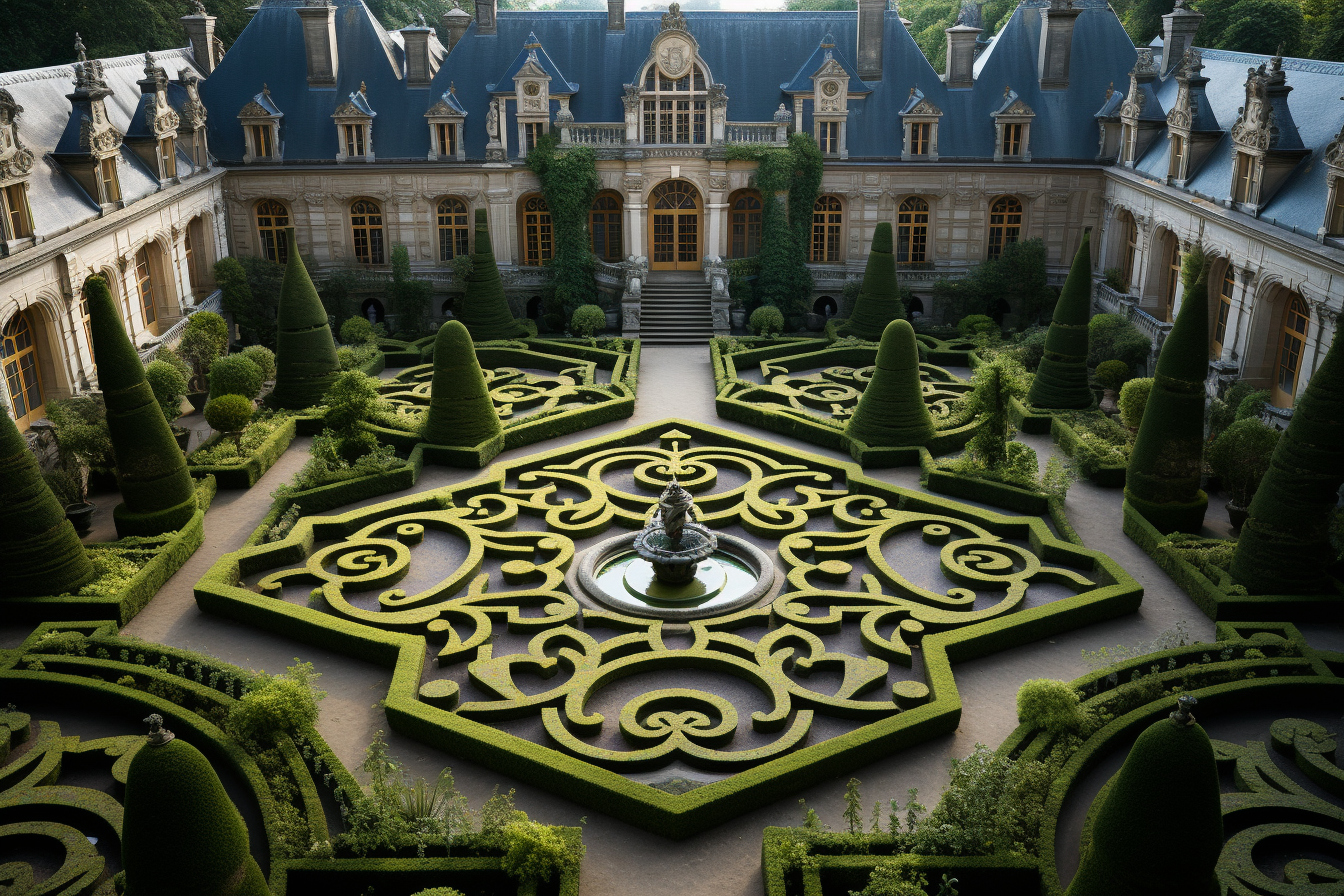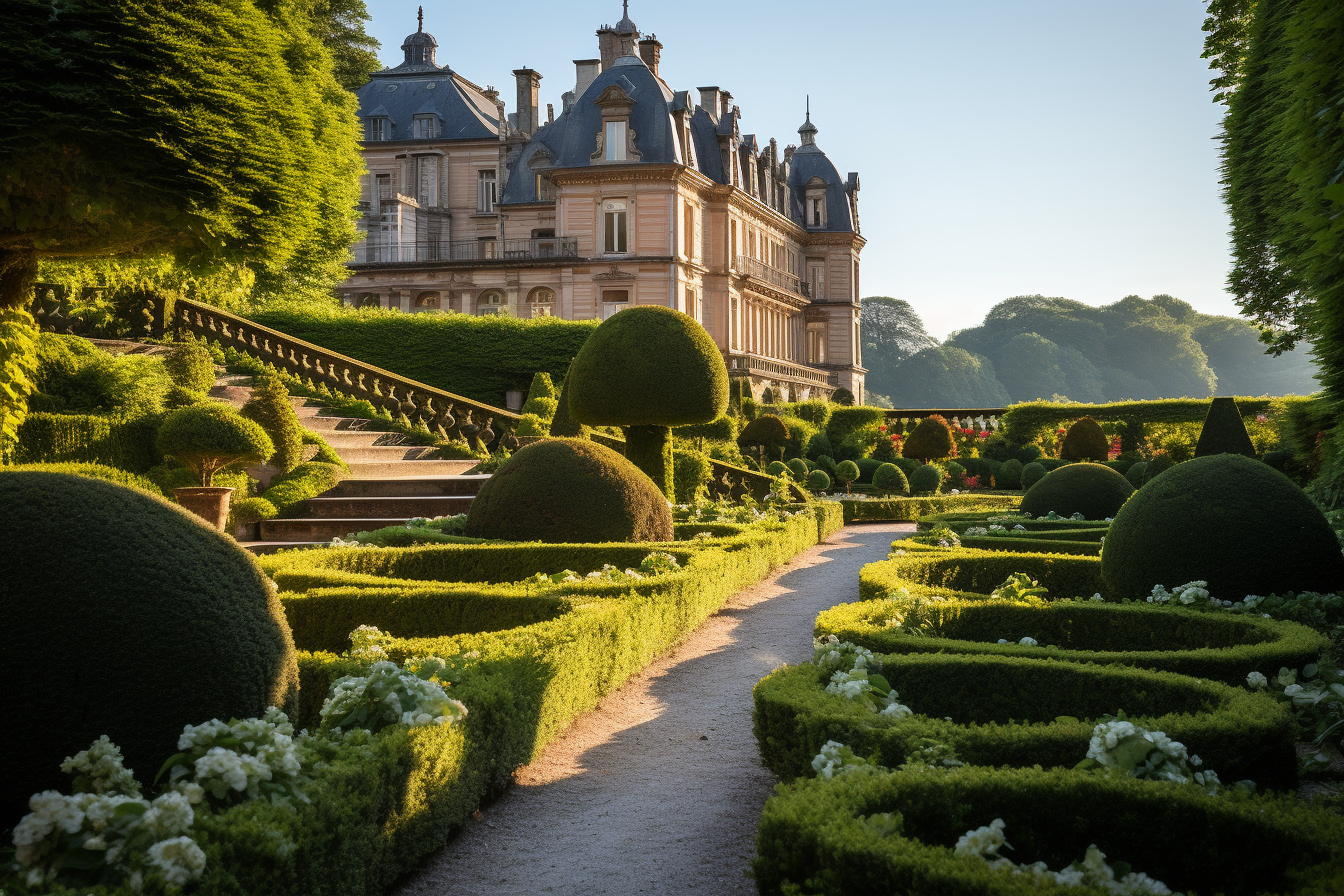The role of French gardens in the history of art is undoubtedly preponderant. These landscape works, true open-air masterpieces, have marked the evolution of art over the centuries. Their influence extends well beyond the simple creation of landscapes: they forged a true aesthetic language, a true artistic school, and inspired numerous artists and architects throughout time.
The invention of French gardens: an artistic revolution
The appearance of French gardens in the 17th century marked a true revolution in the history of art. They are characterized by rigorous symmetry, geometric lines and perfectly calculated perspectives. French gardens thus stand out from English gardens, which are more free and natural.
The creation of these gardens is closely linked to the evolution of artistic ideas of the time. Indeed, the Baroque period, marked by ostentation, pomp and the search for perfection, found in French gardens a perfect reflection of its aesthetic values.

A total art: the French art of living
French gardens are not limited to being simple decorations. They are designed to be an extension of the castle or residence that surrounds them. Thus, each element of the garden contributes to creating harmony between the architecture and the landscape. The paths, the fountains, the flower beds, the sculptures, all these elements are carefully thought out to create a unique atmosphere.
French gardens are also a testimony to the French art of living. They were designed to be walked through, admired and used by nobles and courtiers. Long walks on perfectly trimmed paths, refreshing water features and elegant green rooms were activities favored by the aristocracy.
Inspiration for artists and architects
French gardens have been a source of inspiration for many artists and architects. Painters found in these rigorous and ordered landscapes a new way of representing nature. The sculptures in the gardens also offered them a favorite subject, capturing human movements and expressions in frozen poses.
As for architects, they saw in French gardens a real lesson in composition and perspective. The games of symmetry, the perfect alignments and the calculated perspectives nourished their thinking and influenced the very architecture of the buildings. The facades were decorated with geometric lines and the French gardens became a real source of inspiration for creating harmonious outdoor spaces.
The heritage of French gardens
Although French gardens reached their peak in the 17th and 18th centuries, their influence continues today. Elements of these gardens can be found in many parks and gardens around the world. The large straight paths, the mirrored pools, the geometric plantings are all nods to this bygone era.
The international influence of French gardens
French gardens, while deeply rooted in the cultural and historical identity of France, have crossed borders and influenced garden designers around the world. These landscape wonders, through their uniqueness and perfection, served as a model for landscapers and horticulturists of other nations.
North America, for example, has integrated elements of French gardens into some of its historic parks. This is evidenced by certain spaces on the east coast of the United States, where the search for symmetry and the rigor of lines are directly inspired by the gardens of the French Baroque era. Likewise, nations like Russia and Germany, although having their own gardening traditions, also borrowed from French art to design royal or princely gardens.
China and Japan, renowned for their Zen gardens and their own aesthetics, were also touched by the excitement of French gardens during cultural exchanges. Without abandoning their essence and founding principles, certain Asian gardens have integrated elements of order and geometry, thus testifying to the fusion of two distinct aesthetic worlds.
But beyond the visual aspect, the very essence of French gardens, based on harmony, perspective and perfection, has inspired garden designers around the world to seek these same principles in their creations. They thus aspired to recreate this feeling of majesty and grandeur, while adapting it to the cultural and climatic specificities of their region.
The symbiosis of French gardens with modern ecology
The evolution of the way we look at nature
French gardens, with their rigorous and geometric aesthetic, were designed with the aim of bringing order and control to nature. However, with the passage of time and the evolution of our relationship with nature, a new trend is emerging: integrating ecological principles into these traditional gardens.
Today, many landscapers and environmentalists recognize the value of a more holistic and environmentally friendly approach. This transition is manifested by an awareness of the need to preserve biodiversity, maintain a natural balance and recognize the intrinsic value of each living organism.
The integration of permaculture in French gardens
One of the most influential movements in this new paradigm is permaculture, which aims to create agricultural and social production systems that are both self-sufficient and sustainable. How can we then merge the rigorous aesthetics of French gardens with the ecological principles of permaculture?
Formal gardens could incorporate elements such as diversified planting areas, which encourage greater biodiversity and interdependence of species. The beds could be planted with native varieties, which use less water and are better adapted to the local climate. Water features, such as ponds and fountains, could be transformed into habitats for local wildlife, while retaining their aesthetic role.
Gardens, mirrors of contemporary concerns
The revival of interest in French gardens is not just a matter of aesthetics. It is also the reflection of a growing desire to reconnect with nature, to understand its mechanisms and to respect it. These gardens can then become educational spaces, where visitors learn the importance of biodiversity, water conservation and sustainable farming methods.
The therapeutic dimension of French gardens
The relationship between man and nature has always been at the heart of human concerns. In modern society, where the pace of life is accelerating and green spaces are rare, gardens play a crucial role for the mental and emotional balance of individuals. French gardens, with their orderly structure and calming aesthetic, can offer a unique experience of well-being and serenity.
A haven of peace for the mind
Walking through the symmetrical paths of a French garden can have a meditative effect. The clean lines, the perfectly drawn perspectives and the general harmony of the landscape invite contemplation and reflection. For many, simply being in such an environment can help reduce stress, anxiety and promote a sense of inner peace.
Gardens as therapy tools
Gardening therapy, or hortitherapy, is a practice that is growing in popularity. She uses gardening activities to improve the mental, emotional and sometimes physical well-being of individuals. Although formal gardens were not originally designed with this in mind, they can nevertheless provide an ideal setting for this type of therapy. The regularity of their design can provide a sense of structure and stability, while contact with plants and nature promotes relaxation and concentration.
French gardens and contemporary society
Current concerns around mental health and wellbeing echo the need to reconnect with nature. In this context, French gardens, with their structured and considered approach to landscaping, can offer a suitable response. They become spaces where aesthetic beauty meets therapeutic function, thus contributing to a balance between body and mind.













